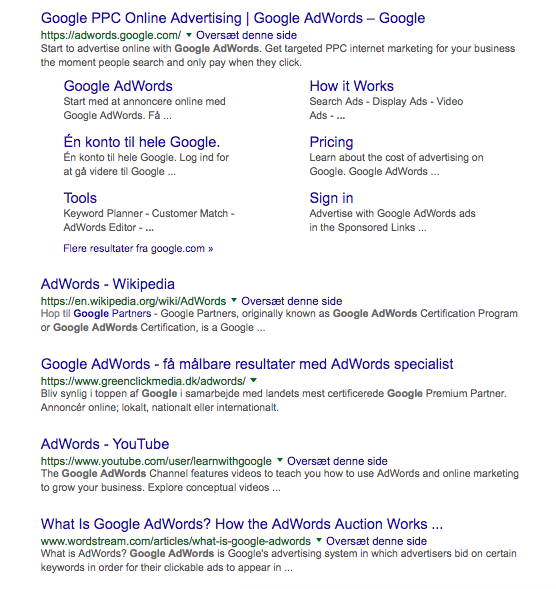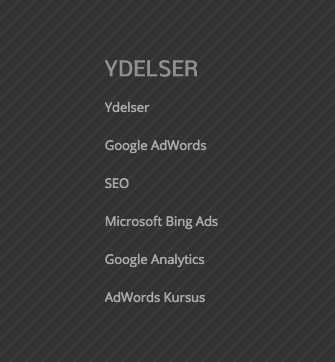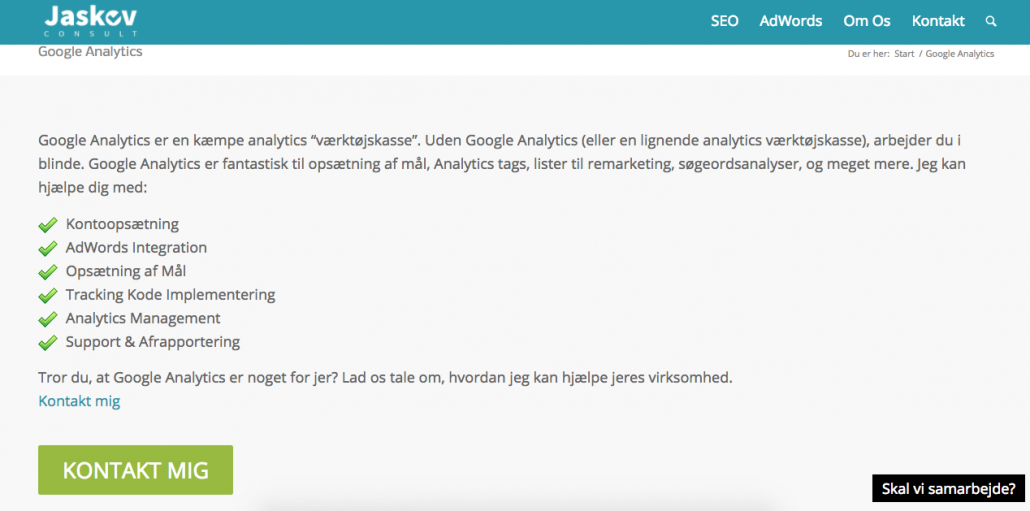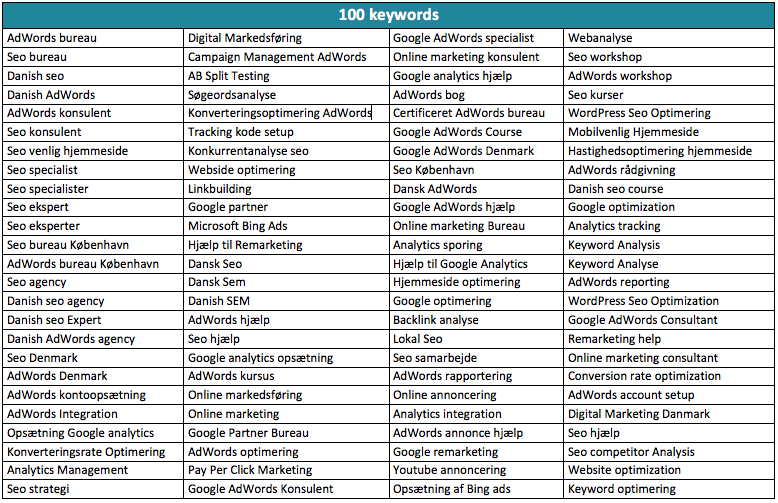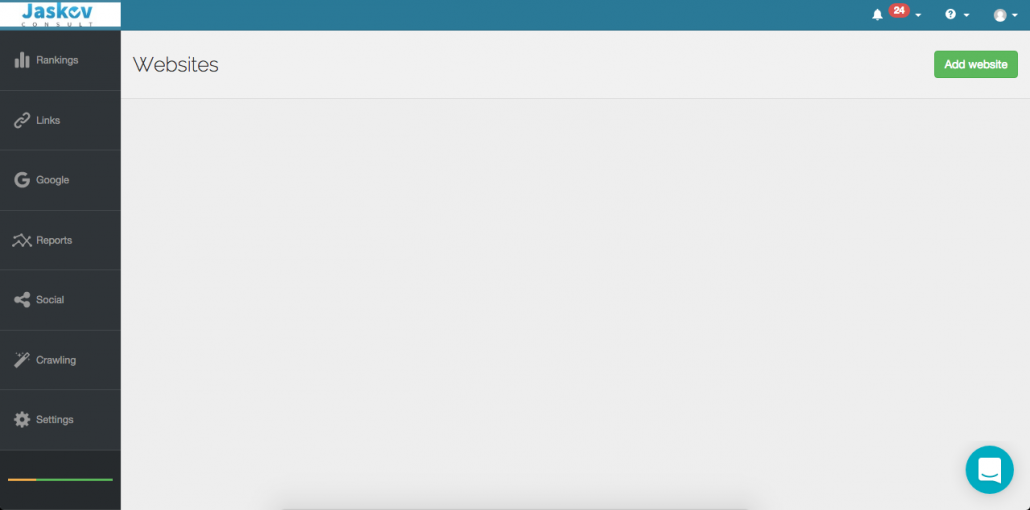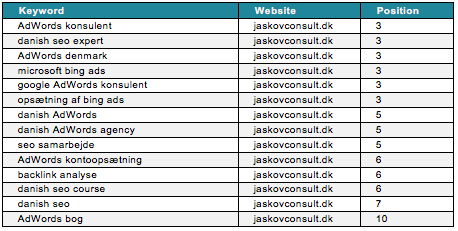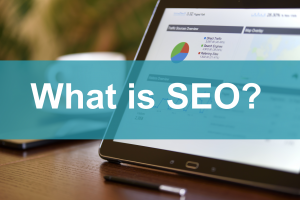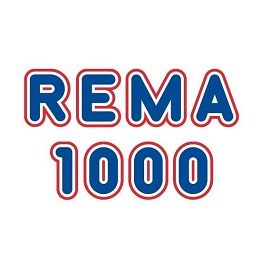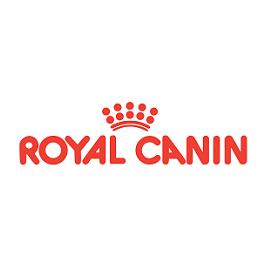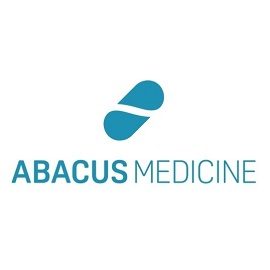There is absolutely no doubt, that a keyword analysis is a very important part of your online marketing strategy. If you are not already aware of this, it is about time to update your knowledge concerning this topic. There are multiple different methods to deal with keyword analyzes. This article is a tutorial on how it could be done in a simple and efficient way, and is, among other methods, a method we have used with huge success at Jaskov Consult.
What is a keyword analysis and why is it important for you?
A keyword analysis is very important, since it is keywords that assure the connection between you and your customers. When your customers search for different words that are aligned with your webpage or product specifications, it is essential that your webpage contain the same words. If not, there is a pretty small chance that your webpage will appear in Google’s organic results. If you, on the other hand, have a lot of useful and informative text on you webpage, which contains the keywords your customers use when they search the web, there will be a much higher chance that your webpage will be ranked high on Google. It is worth to mention that keywords are not the only factor that determines whether your webpage ranks high or low. It is important to also consider technical SEO. If the world of technical SEO is new to you, we have written a guide on how to do a technical SEO analysis.
You may ask yourself why it is important to be ranked high in Google’s organic results? This is not something Google has confirmed themselves, but many different studies shows that about 33% of every person, will click on the position 1 in Google, whereas 18% clicks on position 2. This means that you need to have a very high ranking, in order to obtain visitors through the organic results. We usually say that you preferably should be ranked in top 3, in order to achieve a big increase in traffic to your webpage. The advantage of having a lot of traffic to your webpage through the organic results is that it is free, as apposed to traffic through Google Ads (AdWords).
Tough competition
The road to page 1 in Google is neither easy nor fast, and there can be tough competition on many different keywords. An alternative to building up your keyword analysis is to find keywords that have a low competition, but where you can deliver a relevant result to visitors. For example, there is a very high competition on the keyword “Google AdWords”.
Here you need to compete Google itself, and some of the really big competitors, such as Wikipedia. This is an almost impossible task for many companies, whereas it is a lot easier to obtain a high rank with keywords such as “Google AdWords consultant”. In this case, Jaskov Consult is ranked no. 2 in Google’s organic results. So even though there is less searching for “Google adwords consultant” than “adwords”, it is likely to be more beneficial for you and your company to focus on less searched keywords, since it is much easier to rank high on these, which in the end means more traffic.
The “real” traffic
A lot of traffic alone is not the final goal with your SEO work. The goal is not exclusively to achieve a lot of traffic on your webpage, but instead to achieve the real traffic. If people click into your webpage and do not find the content relevant, it can end up with being more harmful to your SEO, and in worst case it can mean a lower ranking in Google. A smaller number of high quality visitors can easily be more effective for your webpage/company, than a lot of visitors that quickly leave the webpage again. That is because of the fact that Google looks at statistics about whether the visitors find your webpage relevant compared to different keywords. An example could be that users of Google find their way to your webpage, after searching for “adwords bureau”. If these visitors stay on your webpage for a long time, and clicks on many different topics inside your pages, Google consider it as a positive sign, and your webpage becomes relevant when people search for “adwords bureau”. A webpage with visitors quickly leaving will be ranked lower.
How can you see if it is a good keyword?
The first step may seem obvious, but it is always a good idea to ask yourself, whether the keyword makes sense compared to your product.
Is it a relevant keyword for my webpage? Is it too general? Here you can for example search for it in Google, and see what kind of answers that appear. If all your competitors appear, then it is probably a keyword you would like to be ranked high upon. Whereas, if it is only random things that appear, the keyword is probably too general, and you should choose another one that is more precise.
The process
There are a lot of different programs you can use to make your keyword analysis. This guide builds upon a very simple procedure. The purpose of the procedure is to come to conclusion about a longlist of keywords that you want to be ranked high upon. Subsequently the guide describes how to track your performance on these keywords, and almost just as important, how to hold it against your competitor’s performance.
Depending on what kind of webpage you have, it can vary whether you should find keywords on category level or not. If you have a webpage with many products, every product can easily have 10+ keywords. If we assume that you have a webpage with 3.000 products, it can suddenly be an unmanageable project, if you need to find around 30.000 keywords, you would like to be ranked high upon. We would rather recommend, that you make a further breakdown of your keywords in respectively category and product level. This breakdown is roughly similar to entering a supermarket, and searching for products on your shopping list. On category level you will find words such as “vegetables”, “butcher”, “toys, “electronics”.
On product level you will find the specific products such as “organic carrots”, “Danish strawberries”, “beef tenderloin”, “minced meat”, “LEGO Mindstorms”, “Playmobil princess dream castle”, “Sony DVD player”, “Nikon compact camera”.
You have presumably noticed that you easily can reach thousands of keywords on product level. On category level, you contrary have to work hard to reach a couple of hundreds of keywords. The difference on the keywords you find on category level and product level is that the words on product level usually have a higher conversion rate than the words you find on category level. This is aligned with the way people customize their searching. Imagine that your 5-year-old son tells you that he wants LEGO Mindstorms for his Christmas present. You are a busy person, so after son. You open your computer and make a search on Google. There is probably a high probability that you do the following:
Step 1: You open Google.com
Step 2: You search for “Lego mindstorms”
Step 3: You click into a toy store and buy a package of LEGO Mindstorms.
In other words, the conversion rate is high because you know exactly what you need to buy.
Here is another scenario. You also have a 4-year-old daughter. She has not really found out what she wants for Christmas. She tells you to write the following on her wish list: “toys”.
Your searching process will here look different. You first need to make some research on what kind of toys that exist. Your actions will probably look like this:
Step 1: You open Google.com
Step 2: You search for “toys”
Step 3: You click around into different toy stores, and gather inspiration, but you don’t buy anything. Among other things, you find out that Playmobil has produced a pretty princess dream castle, which could be interesting for your daughter.
Step 4: You open Google.com again
Step 5: You search for “playmobil princess dream castle”.
Step 6: You click into an online toy store and buy 1 piece of a Playmobil princess dream castle.
As you can see, the buying process is a bit different, than the one you had when you needed to buy a present for your 5-year-old son. In that example you knew exactly what he wanted. You made one simple search in Google, and then made the purchase.
In the example of buying a present to your 4-year-old daughter, you needed to start the process with a little research. You ended up with making two searches in Google. The first searching was a keyword on category level: “toys”. The next searching was a keyword on product level: “playmobil princess dream castle”.
Your first search did not convert. On the other hand, your next search did.
This type of behavior is often something that happens. Therefor it is important to understand that buyer behavior is an essential part in your choice of keywords. Please don’t have the impression that you should stay away from category level keywords, as they usually are very important, since they usually has a lot of traffic. They are therefor good to advertise upon, since they are great at increasing the knowledge around your company. Additionally they are also good to make remarketing (also called “retargeting”) campaigns upon. The fact is, that your product level keywords more often will convert better if a user has visited your webpage at least one time earlier.
If you want to know more about consumer behavior, it would be an advantage to read more about for example the AIDA-model.
Step 1: Longlist with keywords
In step 1, we find a lot of different keywords, and add them to a longlist in Excel. www.jaskovconsult.dk is a website that mainly deals with online marketing, where the primary focus is on Danish Google Ads (AdWords) and Danish SEO. An easy way to find keywords is first to divide the webpage into categories. Jaskov Consult has the following overview on the webpage:
Here you can easily see that the webpage works with Google Ads (AdWords), SEO, Microsoft Bing Ads, Google Analytics and Google Ads (AdWords) courses. Here you have your first keywords, that overall are the categories the webpage deals with, and therefor very relevant for your keyword analysis.
Afterwards you can dive into the different kinds of categories to find more keywords. In this example it contains the services the webpage offers. If it is a webpage that sells physical products, you can quickly make a simple extract of the database and find the categories there. It could for example be a store that sells furniture. You would easily manage to make a list of different furniture categories such as dining table, coffee table and dining chair. In the example with Jaskovconsult.dk we choose to click into the categories to find different keywords. In this example I choose Google Analytics.
When we click into the Google Analytics webpage, we quickly notice a small overview on what Jaskov Consult offers of services in connection with analytics:
By looking at the overview, I quickly find many different keywords, such as “kontoopsætning” (account setup) and “adwords integration”.
Again it is important to think one extra time, when searching for keywords. The word “kontoopsætning” (account setup) is probably too general. If you change it to “Google AdWords setup”, it will become more precise, and I can therefor add it to my list of keywords.
Every time I find a new word, I add it to my Excel sheet. The result becomes a list with 100 different keywords, both in Danish and English.
Remember to check if all the words are relevant. This can be done, as earlier mentioned, by searching in Google for different keywords.
Step 2: Keyword rankings report
It is always important to measure how your rankings are compared to the different keywords. Otherwise it can be very hard to determine what to do, in order to make your webpage rank higher. If you for example start to add a lot of useful content to your webpage, you will probably raise in the organic results. You have to measure the effect of that, and it can be done in a simple way. As earlier mentioned, you can at the same time measure how your competitors perform compared to your webpage.
I have chosen to use a popular ranking tool called Advanced Web Ranking to track what position Jaskov Consult is ranked on all the 100 different keywords.
Part 1:
The good thing about this tool is that you can simultaneously measure your position against your competitors. I will do this in the following example.
Click into Awrcloud.com. It cost some money to have a user in there, and the prices may vary between $49 to $499, depending on how you are going to use the program.
When logged in, you need to enter the front page and click ”add website” in the right corner.
Then you have to enter the different information that the page asks you for. In this example, I enter the Website URL, Name, Country, Result page depth and Update frequency.
I choose Denmark as the country, since I want to study how Jaskovconsult.dk is performing on the Danish Google. One can choose how often one wants the page to make such a report. I choose to set “update frequency” to a month, which means that I get a new report every month.
Then you need to fill out the keywords you wish to track. Here I enter my 100 words long list. It is these keywords that I will now receive a detailed report about.
Afterwards you need to choose what search engine you wants to see rankings from. In this example I only choose Google.
The last step, you can choose to skip. This is the step where you add your competitors. By adding your competitors, it is possible to see how you perform in comparison with these, on the different keywords you have filled in. To illustrate how this function works, I have selected 3 of Denmark’s most skilled agencies, including OnlinePartners, River Online and Obsidian.
When all this is done, you press “add website”. Now the advanced web ranking start to prepare the report. This can take up to 24 hours before finished.
The report
When the report is done you can download it on Advanced Web Ranking’s website, by logging into your account. You can choose to download it in different formats. I prefer to download it in Excel format, so that you are able to deal with the setup yourself.
Here I have chosen to take out a little part from the downloaded Excel sheet. The part shows the keyword where Jaskovconsult ranks in top 10. The same report can be downloaded for the competitors I added earlier, and in that way I can compare the webpages to each other.
Now you have learned how to make a keyword analysis. It is time to start the SEO work and see how it affects your rankings.
Good luck!


